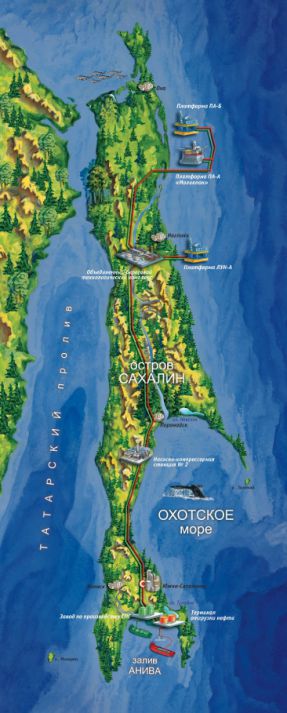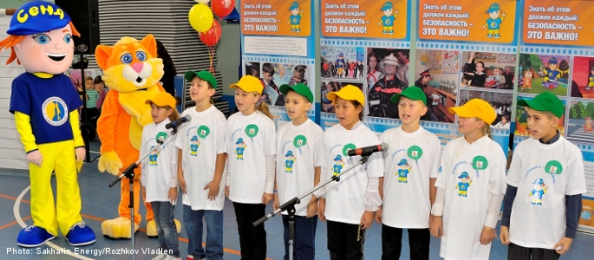Responsible Engagement - Core Element of Securing Human Rights
Sakhalin Energy Investment Company Ltd. (Sakhalin Energy) is the operator of the Sakhalin-2 project, which involves the development of two oil and gas fields offshore from the Sakhalin Island.
Sakhalin-2 is one of the world’s biggest integrated oil and gas projects. The company was established in 1994 specifically for the development of this project. Since 1999, the company has been producing oil from Molikpaq – Russia’s first offshore ice-class platform – as part of Phase 1 of the project, during ice-free seasons. Two more offshore platforms were built and commissioned during Phase 2, which also included the following: around 300 km of offshore pipelines to connect all the platforms to the shore; some 1,600 km of onshore oil and gas pipelines; an onshore processing facility; an oil export terminal; and Russia’s first liquefied natural gas plant, launched in 2009. As Russia’s most innovative and technologically advanced project, Sakhalin-2 plays its part in the overall development of the Russian oil and gas industry.
In recent decades, more attention has been paid to the social responsibility of business and the effective cooperation between business, governments, and society. Global experience has confirmed that only businesses that follow responsible business practices can achieve long term success. These practices are based on respect for human rights, transparency, non-financial reporting, environmental responsibility, caring about personnel, and making contributions to the sustainable development of the region.
| Initiator | Sakhalin Energy |
| Project start | 2009 |
| Status | ongoing |
| Region | Sakhalin, Russian Federation |
| Contact person | Natalia Gonchar |
| Awards | - |
Project benefit
- Integration of the local populace into the decision process of the company
- Safety training for the locals
- Grievance management, thus helping to focus occuring problems and take actions.
| Anti-Corruption | - |
| Business & Peace | - |
| Development | - |
| Environment | - |
| Financial Markets | - |
| Implementing UNGC Principles in your Corporate CSR Management | - |
| Human Rights | X |
| Labour Standards | - |
| Local Networks | - |
| Advocacy of global issues | X |
| Business opportunities in low income communities/countries | - |
| Project funding | - |
| Provision of goods | - |
| Provision of services/personal | - |
| Standards and guidelines development | - |
- EMERCOM
- local NGOs
In the age of economic globalization and the current financial crisis, corporate social responsibility (CSR) assumes special significance. What are the benefits that responsible business practices can provide? Internally, this is an effective risk-management mechanism that can prevent or minimize the problems within a company, with contractors, or across an entire value chain. Externally, this gives an opportunity to share best CSR knowledge and to promote it globally, which, in the end, contributes to global sustainable development.
For Sakhalin Energy, the five CSR pillars are:
- observance of and respect for human rights
- accountability and transparency
- ethical behavior
- respect for stakeholders’ interests
- supremacy of the law and compliance with internationally accepted codes of conduct
Effective stakeholder engagement is an important and integral element of successful operations of the company. The statement on transparent and open stakeholder engagement is included in the company’s General Business Principles. Sakhalin Energy uses a systematic and proactive approach based not only on Russian national standards but also on the best international standards. Special engagement programs are carried out for communities and vulnerable groups that may be affected by the company’s activities.
Sakhalin Energy’s engagement with stakeholders is based on the commitments set forth in the key corporate documents, which include:
- “Statement of General Business Principles”
- “Sustainable Development Policy”
- “Commitments and Policy on HSE and Social Performance”
- “Public Consultations and Information Disclosure Specification” of Social Performance Standard
- “Public Consultation and Disclosure Plan”
The above-listed documents define the engagement strategy, principles, mechanisms, and tools. The company reports on engagement outcomes primarily via public consultations and information disclosure reports.
Stakeholder engagement mechanisms and tools are selected based on the stakeholder engagement goals and the stakeholder group.

Five basic complementary and interdependent mechanisms are used:
- Impact assessment – free, prior, informed, participatory consultations with project-affected communities.
- Ongoing three-level system of direct communication with community – open public meetings; focused / group / individual meetings and workshops; Community Liaison Officers’ open hours and special information centers in local libraries in 23 Sakhalin communities, etc.
- Grievance addressing procedures.
- Partnerships – strategic cooperation with public and authorities in delivering social and environmental projects based on co-ownership and equitableness.
- Public reporting – primary annual Sustainable Development report prepared as per Global Reporting Initiative and AA1000 standards.
All of them proved their efficiency and value, both for business and stakeholders during all project development phases of Sakhalin-2.
Grievance management
Large-scale projects like Sakhalin-2 inevitably generate questions and concerns for residents living in the project area. In order to ensure that public grievances are processed in a timely and effective manner and in accordance with international best practice, the company developed and implemented its Grievance Procedure.
This procedure is one of the key elements demonstrating the social responsibility, respect for human rights, and high social standards adopted by the company. The procedure guarantees that grievances are resolved in a timely and effective manner, that they are less likely to reappear, that they are properly documented, and that the respective corrective and preventive measures are taken.
The following are key principles of Sakhalin Energy’s Grievance Procedure:
- Legitimacy and incorporation into management systems (the grievance procedure consists of elements and mechanisms that ensure trust by stakeholders and affected groups targeted by this procedure). The Grievance Procedure includes independent procedures of assessment, resolution, and monitoring of grievances. The grievance status and progress are controlled by the company’s top management, and audited both externally and internally. Furthermore, the grievance handling process is assessed by the company’s inter-directorate committees, registered, and tracked in the automated incident tracking system.
- Accessibility (ensuring awareness of all targeted stakeholders). There are different channels for logging grievances, thus making the company accessible when communicating with complainants. Among those channels are the company’s information centers, Community Liaison Officers, a dedicated hotline, email addresses, etc. Regular awareness campaigns and trainings are held to keep communities and contractors / subcontractors fully informed. The company uses feedback from the population and other stakeholders to assess the effectiveness of these channels.
- Transparency and openness. The company regularly informs all stakeholders on the status and progress of grievance processes, provides enough details on its results, and incorporates the grievance updates in public reporting.
- Stakeholder engagement and ensuring dialog while addressing grievances. Sakhalin Energy conducts regular consultations with communities and other various stakeholder groups with regard to the effectiveness of the process for addressing grievances. Such consultations are part of the community engagement with focus groups and constitute an integral part of internal social performance monitoring. Special emphasis is put on dialog with complainants as part of the process for addressing grievances and the decision making required for its resolution.
- Predictability in terms of process and ensuring concerted actions. It is a clear and straightforward procedure, which sets time limits for each stage of grievance handling and communication with complainants throughout the whole process.
- Confidentiality. All grievance-related issues are addressed confidentially. Information of complainants is not to be disclosed without a complainant’s written consent.
- Applicability both for the company and contractors. The company’s Grievance Procedure is mandatory for all of the company’s functions, as well as for its contractors and subcontractors.
- Using the experience gained for preventive and proactive measures and continuous improvement. All grievances filed with Sakhalin Energy are tracked and the tendencies are analyzed. Based on such analysis, recommendations are formulated for the company’s respective functions and contractors / subcontractors with respect to impact mitigation and preventive measures.
Safety is our first priority
Safety is one of the most critical human needs, along with the need for food, water, and housing. Globally, more than 220 million people are annually affected by natural disasters, and more than 66 million of them are children. A child’s safety is an overall priority, as children are more vulnerable and helpless in a dangerous situation. The Asia Pacific region is vulnerable to many types of disasters. The environment conditions of Sakhalin Island, located in the Russian Far East, resemble those of the true Arctic. In addition, the island has a high seismicity and susceptible to other natural calamities such as hurricanes, tsunamis, forest fires, etc. Operating in the harsh environment of the island, Sakhalin Energy uses a systematic approach regarding health, safety, security, and environmental management in order to ensure continuous improvement in performance. The company is seeking to achieve the highest standards and is following corporate principles and values, with a key focus on safety.
At the same time, effective stakeholder engagement and appropriate communication regarding safety has become one of the key priorities of Sakhalin Energy. Educating children on rules of conduct during emergencies is a critical element of community preparedness. Due to the complexity of the goal and the significant area of coverage, a partnership was established between Sakhalin Energy, the Sakhalin Ministry of Education, and the Ministry of Emergency Situations (EMERCOM). The partnership promotes rules of safe behavior in order to minimize the risk of children finding themselves in emergency situations. These efforts have been realized through the Sakhalin Energy’s program “What to Do in Emergency Situations.”
“Implementation of a project like this would not be possible without strict adherence to the best international standards in business ethics and corporate social responsibility (CSR), and sometimes even development and implementation of new standards. Strong, transparent, contractive, and systematic cooperation and two-way communication with all groups of stakeholders has proved to be the backbone of success and has been highly appreciated by all groups of stakeholders and experts.”
Andrei Galaev, CEO of Sakhalin Energy
The program
“What to Do in Emergency Situations” has been in operation since 2005. The program introduces modern technology and safe behavior education for preschoolers and school-age children. These children can, in turn, teach preparedness for emergency situations to their relatives and friends. The integrated program is implemented using four main means:
1. Educational cartoons

Image: Sakhalin Energy
Specially created animated cartoons aim at enhancing children’s awareness of safe behavior in different situations. The main character of these clips, a boy named Senya, teaches children the rules of behavior in emergencies and ways to prevent dangerous situations in a simple and understandable form. The cartoons’ topics cover many dangerous situations that children would find in a modern society: road traffic, games on the ice in winter, bathing in unknown water basins, earthquake, tsunami, snow avalanche, etc. The cartoons have undergone expert review in the Russian Emergency Psychological Aid Centre of EMERCOM and are used in different regions of Russia.
2. Resource classrooms for life safety fundamentals
Resource classrooms for conducting lessons on “Fundamentals of Life Safety” have been equipped and opened in 12 Sakhalin districts.
These classrooms are used for conducting lessons for students of schools where the resource classes are located, as well as offering activities for parents and students of other educational institutions, teachers from other districts, and the general public. In 2011 a professional contest was organized for specialists teaching safety essentials. More than 40 teachers from 13 Sakhalin districts participated. One result of the contest was a book of best teaching practices, “Fundamentals of Life Safety,” which was published and distributed in all Sakhalin schools and libraries.
3. Special safety events
The special events involving preschoolers and primary school children are held on a regular basis and are targeted to consolidate and practice knowledge about the rules of safe behavior. Using role play techniques, life-size puppets – the animated cartoon character Senya and his friend Vas’ka the Cat – remind the young participants about the safe behavior rules and conduct subject trivia games. Such events are always an ap preciated break for the young residents of the island.
The biggest event is traditionally arranged on the second Wednesday of October – the International Day for Natural Disaster Reduction. Hundreds of schoolchildren from all over Sakhalin take part in safety contests and receive expert refereeing from EMERCOM professionals.
“A topic unusual for corporate programs should be noted – safety of children and promotion of behavior rules in emergencies, which is however a fairly urgent problem for residents of Sakhalin and Kamchatka. The partnership with relevant organizations, first of all, with regional EMERCOM, ensured the professional approach and high level of execution of all the program elements – from the cartoon clips to the life safety classroom equipment.”
The Corporate Donor, All-Russian contest for Best Social Investment Practices, arranged by PricewaterhouseCoopers, Vedomosti newspaper, and the Forum of Donors.
4. Special safety projects
- The special project “Senya and I go to School” is targeted at first-grade pupils. Going to school marks the start of a new period in a child’s life. It is naturally characterized by greater independence and more responsibility, including responsibility for personal safety. Under this project, each firstgrade pupil of Sakhalin (in total about 5,000 children) was presented with a comics book based on the animated cartoons of Senya’s adventures. The lessons and events devoted to life safety fundamentals were conducted in all Sakhalin schools.
- Sakhalin is a place with magnificent landscapes. Many Sakhalin families are keen on hiking. The project “Safety of Tourist Routes” was naturally supported for implementation by all partners. The ecological trail to Chekhov Peak – the most popular tourist route among Sakhaliners – was properly equipped and accompanied with information stands. It was coupled with an informational and promotional event on safe hiking, as well as a creative contest: On a Hike with Senya. More than 500 creative works were submitted.
- The special project “Senya Warns” includes the marking of tsunami and snow avalanche danger zones as well as a dedicated information campaign. In 2011 it was launched in Nevelsk, a Sakhalin district that suffered from an earthquake and its consequences in 2007.
In 2011 the program website was launched (www.senya-spasatel.ru) with all program-related materials made available, making it helpful for teachers, parents, and children. One can find promotion materials on safety essentials to be used in class (cartoons, comics books, handouts, etc.) or for after-school activities (scenarios of the events), and watch favorite cartoons online.
A partnership approach and joint publicprivate efforts have allowed all participants to consolidate resources effectively and carry out actions more productively and on a substantial scale.
Program recognition was analyzed in the course of an independent public opinion survey. It confirmed 90 percent recognition of the program among children. Can Senya be more popular than Mickey Mouse?... For Sakhalin, the answer is yes.
“Implementation of the ‘What to Do in Emergency Situations’ joint program for Sakhalin EMERCOM is one of the ways to train the population in the sphere of life safety. In addition, this program helps increase the efficiency of educating children – the hero of the cartoons Senya and his advice on safe behavior rules are well-known to young residents of Sakhalin and the Kuril Islands. Children are our future, and ‘What to Do in Emergency Situations’ contributes to making it safer.”
Taimuraz Kasayev, Chief of Sakhalin EMERCOM
Natalia Gonchar works for Sakhalin Energy Investment Company.
Marina Ee is Head of Social Assessment, External Affairs Department of Sakhalin Energy Investment Company.
Elena Alyokhina has been working for Sakhalin Energy.
Sakhalin Energy Investment Company Ltd. (Sakhalin Energy) is a consortium for developing the Sakhalin-II oil and gas project with corporate head office in Yuzhno-Sakhalinsk. The chief executive officer is Roman Dashkov. The company's principal activities are the production and export of crude oil (since 1999) and liquefied natural gas (from 2009).
Source: Wikipedia
Write a comment about this page
Your comments are provided by your own free will and you take sole responsibility for any direct or indirect liability. In order to maintain the highest discussion quality, all comments will be reviewed by our editors. You hereby provide us with an irrevocable, unlimited, and global license for no consideration to use, reuse, delete or publish comments in accordance with our Community Guidelines.
About Us // Privacy Policy // Copyright Information // Legal Disclaimer // Contact
Copyright © 2012-2018 macondo publishing GmbH. All rights reserved.
The CSR Academy is an independent learning platform of the macondo publishing group.









